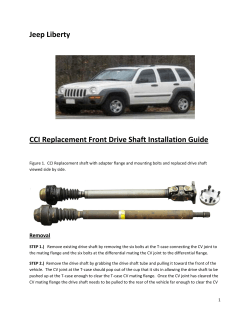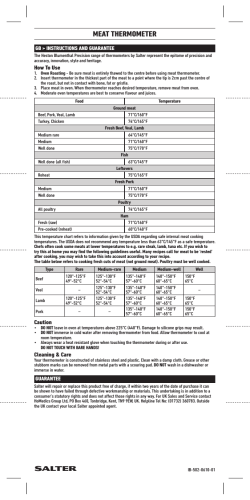
Eight Steps to Thermowell Selection How to Order
How to Order � � 75 W SIZE CODE 50 75 10 12 15 20 30 40 Eight Steps to Thermowell Selection INCHES 1 ⁄2 3 ⁄4 1 11⁄4 11⁄2 2 3 4 � � � � � A thermowell is highly recommended TYPICAL CODE – 75W0750HT260C 0750 U-DIMENSION THREAD H LAGGING T SHANK 260 TYPE C BORE for use with temperature indicating MATERIAL CAP & CHAIN CODE INCHES CODE LAGGING CODE TYPE CODE TYPE 0162 0250 0450 0750 1050 1350 1650 1950 2250 15/8 21⁄2 41⁄2 71⁄2 101⁄2 131⁄2 161⁄2 191⁄2 221⁄2 – L Without With T W F NPT Thd. Weld-In. Flanged Van Stone SocketWeld Limited Space Threaded Ground Joint Sanitary AA Brass Carbon Steel 304 316 V S M G C CODE INTERNAL THD. – 2 1 ⁄2 NPSM 1 ⁄2 NPT B C S VARIATION FACING SEE NOTES 3&4 RATING SPECIAL LAGGING LENGTH CODE RATING # 150 300 600 1500 2500 150 300 600 1500 2500 and control instrumentation to isolate the temperature sensor from the media being measured. A thermowell performs an invaluable triple-duty service; • Protects delicate instrument sensing elements against corrosive effects and resulting physical CODE SHANK CODE DIAMETER H S R B Tapered Straight Stepped Built-up 260 385 .260 .385 CODE MATERIAL 1 2 CODE FACING F R J L Flat Raised Ring-Joint Lap-Joint Brass St. St. SEE damage caused by media flow. NOTE 2 • Permits instrument interchange or calibration check without disturbing or closing down the process. Note 1 – Examples a. 3⁄4˝ NPT – 304 – .260˝ Bore – U – 71⁄2˝ – Tapered 75W0750HT260C b. Same as “a.” except Lagging (Standard Length) 75W0750LHT260C c. Same as “b.” except Special Lagging = 31⁄2˝ 75W0750LHT260CL0350 d. Same as “a.” except Tip Diameter (E) = .500˝ 75W0750LHT260CXDQE500 1 Note 2 – For Special (Non-Standard) Lagging – enter L _ _ _ where _ _ _ = Lagging Length in Inches x 100 Example – 31⁄2˝ x 100 = L0350 Note 3 – For Special Diameters – Enter XDQ and write Identity and Value of Special Diameter below Code, such as “E = .500˝” Note 4 – Other “X” variations will be assigned for special designs 1 e. 1 ⁄2˝ – 300# Raised Face Flange – 316 – U = 10 ⁄2˝ .385˝ Bore – Straight – with Stainless Steel Cap & Chain, Standard Lagging Extension 15W1050LSF385S2R300 Note 5 – • Helps to contain costly or dangerous process fluids when properly installed as an integral part of the vessel or piping. Visit www.ashcroft.com for more information. Or call us direct at If “U” dimension is < 3˝ standard lag = 2˝ If “U” dimension is > 3˝ standard lag = 3˝ 800-328-8258 and let one of our experts help you specify the right thermowell for your application. BULLETIN TH-1 All specifications are subject to change without notice. All sales subject to standard terms and conditions. © Ashcroft Inc. 2012 09/12 Ashcroft Inc., 250 East Main Street, Stratford, CT 06614 USA Tel: 203-378-8281 • Fax: 203-385-0408 email: [email protected] • www.ashcroft.com BULLETIN TH-1 All specifications are subject to change without notice. All sales subject to standard terms and conditions. © Ashcroft Inc. 2012 09/12 Ashcroft Inc., 250 East Main Street, Stratford, CT 06614 USA Tel: 203-378-8281 • Fax: 203-385-0408 email: [email protected] • www.ashcroft.com Eight Steps to Thermowell Selection INTRODUCTION Ashcroft® thermowells are available for light duty applications, high pressures, high temperatures, or high velocity applications; as well as meeting many general service industry needs. Selected on the basis of pressure, temperature, flow, vibration and corrosion parameters, basic thermowell types include: threaded, socket weld, weld in, flanged, sanitary and van stone. The threaded type is generally the least costly and most versatile. Also available are custom thermowells for unique applications. Proper thermowell selection is critical to most applications. To configure an Ashcroft® thermowell part number follow the eight steps. � � � � PROCESS CONNECTION SIZE is the size of the portion of the thermowell that connects with the vessel or pipe. This can be in the form of a thread size, flange size, pipe size, tri-clamp, etc. INSERTION LENGTH is commonly called the “U” dimension, this is that portion of the shank from the process connection (underside of the threads) to the tip of the shank which is inserted into the process area. For the most accurate reading it is recommended that the entire sensitive portion of the bulb be immersed in the media. Example without a lagging extension: Example requirement is for a 7 inch immersion into the process media. This would be the “U” dimension. Requirement is for 4 ½ inch immersion into the process media. This would be the “U” dimension. Add the U dimension to the 1.75 inch dimension for the wrench flats and process connection. This will equal the OAL (overall length). The stem length of the thermometer will be a ¼ inch shorter than the thermowell OAL. “U” 4.50 + “Threads & wrench flats” 1.75 = OAL 6.25. Stem length for bimetal thermometer = 6 inches Example with a lagging extension: Requirement is for 4 ½ inch immersion into the process media and 6” lagging extension. Add the U dimension to the lag plus the 1.75 inch wrench flats and process connection. 4.50 (U) + 6.00 (T) + 1.75 = 12.25 (OAL) Bimetal thermometer stem length would equal 12 inches � � WITHOUT LAG Flange size, flange rating and flange face type are mandatory for proper design and installation. 21⁄2 41⁄2 71⁄2 101⁄2 131⁄2 161⁄2 191⁄2 221⁄2 “S” 4 6 9 12 15 18 — 24 Standard flange sizes are 1˝, 11⁄2˝ and 2˝ with standard ratings of 150#, 300#, 600# and special ratings of 900#, 1500# and 2500#. Face types consist of raised, flat and ring joint. 21⁄2 41⁄2 Add the U dimension to the 2.25 inch flange/installation dimension. This will equal the OAL (overall length). Stem length = OAL - .25 “U” 7 + “Flange/installation dim.” 2.25 = OAL 9.25. Stem length for bimetal thermometer = 9 inches Note: � � � U˝ BORE � � 0.250˝ S˝ Threaded Tapered Well With Lagging Externsion U˝ Root Dia. “B” INSTRUMENT INSERTION LENGTH is commonly called the “S” dimension, is actually a thermometer specification and not a thermowell specification. This is often given in thermowell catalogs for convenience. It is the length from the top of the mounting threads of a thermometer to the end of its stem. S˝ Flanged Well Raised Face Ring Joint 9 15 Flat face flanges are typically used when the mating flange is made from a casting. Flat face flanges should not be mated with a raised face flange. MATERIAL Flat Face 5 9 FLANGED WELLS Threaded Straight Well 2.25 +T ˝ 4 6 Straight shanks are the original design shank style for a protection tube or thermowell. This style would be the considered in a low pressure, low velocity application. Threaded Stepped Well selection is commonly based on corrosion resistance and strength. Selection should be compatible with process media, temperature and velocity as well as the material of the vessel or pipe to which it will be installed. SPECIAL LAG EXAMPLES: Stepped shanks have a significantly reduced tip diameter improving heat transfer to the sensing element. It makes the sensor more responsive to the changes in the process temperature. is the portion of the thermowell which provides the connection with the vessel or pipe. These connections can be integral male threads, prepared surfaces for welding or brazing, flanges for mechanical pressure seals, etc. is the inside cylindrical diameter of a thermowell which is sized to accommodate the stem or bulb of thermal instruments. This dimension can be critical as the tolerance should provide easy installation of the instrument, but a snug fit to minimize thermal lag. Standard bore diameter is .260˝ or .385˝. “S” 6 9 12 15 18 — 24 — Tapered shanks have a smaller diameter tip than the base of the well providing greater stiffness and quicker response time than a straight well. The tapered shank is recommended due to its superior strength and vibration resistance. SHANK CONFIGURATION � “T” 2 3 3 3 3 — 3 — THREADED WELLS Root Dia. Tip Dia. “B” “E” � STANDARD LAG Without these 3 pieces of information you cannot properly select a flanged thermowell. 1.75 +T ˝ is the shape of that portion of a thermowell that is inserted into the process. The tapered shank is recommended as opposed to a stepped or straight shank due to the superior strength and vibration resistance. Typical “S” dimensions for threaded wells “U” is shown as “T” on engineering drawings when applicable. This is used when the vessel or pipe into which the thermowell is inserted is insulated. This is the extra length between the process connection and the instrument connection of a thermowell, which is determined by the insulation thickness. The standard lagging extension is 3˝ (except for thermowells with a 2½˝ “U” the T will be 2˝). Non standard extensions can be supplied although, we suggest 3˝ increments to provide the proper insertion to match standard instrument stem lengths. PROCESS CONNECTION TYPE � Sizing a FLANGED Ashcroft thermowell with an Ashcroft bimetallic thermometer. LAGGING EXTENSION & INSTALLATION WRENCH FLATS � � Sizing a THREADED Ashcroft thermowell with an Ashcroft bimetallic thermometer. Raised face flanges are most commonly found in process plant applications. The raised face has a texture to grip the gasket that is placed between the two flanges. 0.250˝ Tip Dia. “E” Ring Joint flanges are used in high pressure and/or high temperature applications. This flange has a groove that accepts a metal ring gasket which once the bolts are tightened provides a metal to metal seal.
© Copyright 2026














